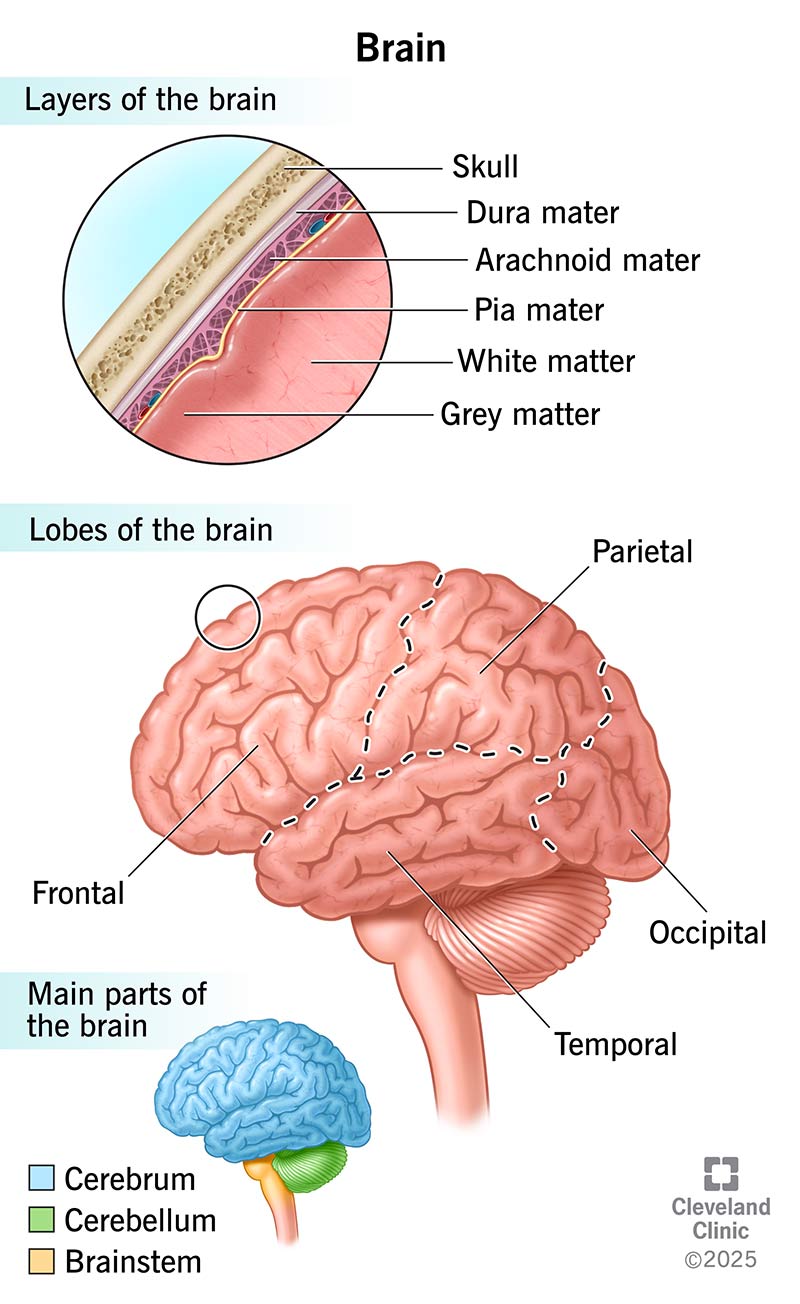Your brain is a major organ that regulates everything you do and who you are. This includes your movement, memory, emotions, thoughts, body temperature, breathing, hunger and more. There are a lot of complex parts of your brain that work together to help you function. Since your brain is always working, conditions are common.
Advertisement
Cleveland Clinic is a non-profit academic medical center. Advertising on our site helps support our mission. We do not endorse non-Cleveland Clinic products or services. Policy

Your brain is a complex organ that regulates everything you do, like your senses, emotions, thoughts, memories, movement and behavior. It even controls body processes you don’t have to think about, like your breathing, body temperature and your heart rate. Everything that makes you uniquely individual comes from your brain.
Advertisement
Cleveland Clinic is a non-profit academic medical center. Advertising on our site helps support our mission. We do not endorse non-Cleveland Clinic products or services. Policy
Your brain is made up of many different parts, each with its own job. But they all work very closely together. This system works by sending and receiving information between nerve cells (neurons) that make up your brain. It then translates this information into a language that your body can understand, so you can function as expected.
Your brain connects to your spinal cord. They make up your central nervous system (CNS).
Your brain is responsible for the following functions:
Your brain’s job is to send, receive and process signals sent through your central nervous system. These signals are messages that carry information from your five senses (sight, smell, sound, touch and taste). Your brain also identifies signals from inside of your body, like pain, temperature or how fast your heart is beating. It interprets or translates this information so you can understand and associate meaning with what goes on around you.
Advertisement
The majority of your brain development happens between birth and your teenage years. But your brain needs time to mature. It’ll continue this process through your mid to late 20s. One of the last parts of your brain to develop and mature is the prefrontal cortex. This part of your brain helps you make decisions, prioritize tasks and regulate your emotions.
Your brain has three main parts:
A bony structure called your cranium surrounds your brain. Your cranium is part of your skull. Your brain floats in a liquid called cerebrospinal fluid (CSF). All the bones of your skull and CSF protect your brain from injury.
Between your brain and skull, you have three layers of tissue called the meninges:
Your brain has 12 cranial nerves. Nerves carry messages by sending electrical impulses back and forth between your brain, organs and muscles. Information from your body passes through your nerves to your brain and from your brain to the rest of your body.
Other important parts of your brain include:
Advertisement
Your cerebrum is split into hemispheres (sides). On each side, there are four lobes (sections) with different functions:
There are two tissues in your brain known as gray and white matter. They differ based on their color and function:
Advertisement
You can compare gray matter to a computer. White matter is the cables for the computer.
There are close to 86 billion nerve cells (neurons) in the human brain and an equal amount of non-neuronal glial cells:
An adult human brain weighs, on average, about 3 pounds. When you’re born, it weighs about 1 pound and grows to about 2 pounds through childhood. The weight of your brain varies based on your sex and body size.
Since your brain is responsible for almost everything you do, brain conditions are common. There are many types of brain disorders and conditions that vary in severity. Some of the most common include:
Depending on the type of condition, you may be born with it or acquire it. Signs and symptoms vary and could affect your mental health, movement, memory, thinking and speech, among other important functions.
Advertisement
Your brain has a really important job, and it often goes unnoticed. Right now, you’re using your brain to read this text. At the same time, your brain is running your body’s motor to keep you breathing, make sure your eyes are blinking and remind you that it’s time for a snack.
Since your brain is constantly working to keep your entire body functioning, it’s important that you take steps to keep it healthy. You can do this by meeting up with friends and socializing, completing puzzles or meditating to reduce stress. The usual habits like eating nutritious meals and getting regular exercise and enough sleep are helpful, too.
Let a healthcare provider know if you have symptoms that might be a sign of a brain condition or if you have questions about your brain health.
If you have a neurological condition, you want expert advice. At Cleveland Clinic, we’ll work to create a treatment plan that’s right for you.

Last reviewed on 01/25/2025.
Learn more about the Health Library and our editorial process.